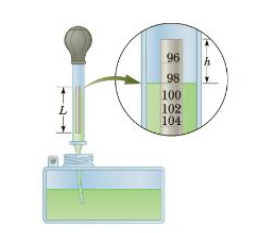1 Units, Trigonometry. And Vectors 2 Motion In One Dimension 3 Motion In Two Dimensions 4 Newton's Laws Of Motion 5 Energy 6 Momentum, Impulse, And Collisions 7 Rotational Motion And Gravitation 8 Rotational Equilibrium And Dynamics 9 Fluids And Solids 10 Thermal Physics 11 Energy In Thermal Processes 12 The Laws Of Thermodynamics 13 Vibrations And Waves 14 Sound 15 Electric Forces And Fields 16 Electrical Energy And Capacitance 17 Current And Resistance 18 Direct-Current Circuits 19 Magnetism 20 Induced Voltages And Inductance 21 Alternating-Current Circuits And Electromagnetic Waves 22 Reflection And Refraction Of Light 23 Mirrors And Lenses 24 Wave Optics 25 Optical Instruments 26 Relativity 27 Quantum Physics 28 Atomic Physics 29 Nuclear Physics 30 Nuclear Energy And Elementary Particles expand_more
9.1 States Of Matter 9.2 Density And Pressure 9.3 Variation Of Pressure With Depth 9.4 Pressure Measurements 9.5 Buoyant Forces And Archimedes' Principle 9.6 Fluids In Motion 9.7 Other Applications Of Fluid Dynamics 9.8 Surface Tension, Capillary Action, And Viscous Fluid Flow 9.9 Transport Phenomena 9.10 The Deformation Of Solids Chapter Questions expand_more
Problem 1CQ: The three containers in Figure CQ9.1 are filled with water to the same level. Rank the pressures at... Problem 2CQ: The density of air is 1.3 kg/m3 at sea level. From your knowledge of air pressure at ground level,... Problem 3CQ: Four solid, uniform objects are placed in a container of water (Fig. CQ9.3) Rank their densities... Problem 4CQ: Figure CQ9.4 shows aerial views from directly above two dams. Both dams are equally long (the... Problem 5CQ Problem 6CQ Problem 7CQ: Water flows along a streamline down a river of constant width (Fig. CQ9.7). Over a short distance... Problem 8CQ: During inhalation, the pressure in the lungs is slightly less than external pressure and the muscles... Problem 9CQ: The water supply for a city is often provided from reservoirs built on high ground. Water flows from... Problem 10CQ: An ice cube is placed in a glass of water. What happens to the level of the water as the ice melts? Problem 11CQ Problem 12CQ: Will an ice cube float higher in water or in an alcoholic beverage? Problem 13CQ Problem 14CQ Problem 15CQ: A person in a boat floating in a small pond throws an anchor overboard. What happens to the level of... Problem 16CQ: One of the predicted problems due to global warming is that ice in the polar ice caps will melt and... Problem 1P: An 81.5kg man stands on a horizontal surface. (a) What is the volume of the mans body if his average... Problem 3P: The weight of Earths atmosphere exerts an average pressure of 1.01 105 Pa on the ground at sea... Problem 4P: Calculate the mass of a solid gold rectangular bar that, has dimensions of 4.50 cm x 11.0 cm 26.0... Problem 5P Problem 6P Problem 7P: Suppose a distant world with surface gravity of 7.44 m/s2 has an atmospheric pressure of 8.04 104... Problem 8P Problem 9P: (a) Calculate the absolute pressure at the bottom of a fresh-water lake at a depth of 27.5 m. Assume... Problem 10P: Mercury is poured into a U-tube as shown in Figure P9.10a. The left arm of the cube has... Problem 11P: A collapsible plastic bag (Fig. F9.11) contains a glucose solution. If the average gauge pressure in... Problem 12P: A hydraulic jack has an input piston of area 0.050 m2 and an output piston of area 0.70 m2. How much... Problem 13P: A container is filled to a depth of 20.0 cm with water. On top of the water floats a 30.0-cm-thick... Problem 14P: Blaise Pascal duplicated Torricellis barometer using a red Bordeaux wine, of density 984 kg/m3 as... Problem 15P: A sphygmomanometer is a device used to measure blood pressure, typically consisting of an inflatable... Problem 16P: Piston in Figure P9.16 has a diameter of 0.25 in.; piston has a diameter of 1.5 in. In the absence... Problem 17P: Buoyant Forces and Archimedes Principle A table-tennis ball has a diameter of 3.80 cm and average... Problem 18P Problem 19P: A small ferryboat is 4.00 m wide and 6.00 m long. When a loaded truck pulls onto it, the boat sinks... Problem 20P: A 62.0-kg survivor of a cruise line disaster rests atop a block of Styrofoam insulation, using it as... Problem 21P: A hot-air balloon consists of a basket banging beneath a large envelope filled with hot air. A... Problem 22P: A large balloon of mass 226 kg is filled with helium gas until its volume is 325 m3. Assume the... Problem 23P: A spherical weather balloon is filled with hydrogen until its radius is 3.00 m. Its total mass... Problem 24P: The average human has a density of 945 kg/m3 after in haling and 1 020 kg/m3 after exhaling. (a)... Problem 25P: On October 21, 2001, Ian Ashpole of the United Kingdom achieved a record altitude of 3.35 km (11 000... Problem 26P: The gravitational force exerted on a solid object is 5.00 N as measured when the object is suspended... Problem 27P: A cube of wood having an edge dimension of 20.0 cm and a density of 650. kg/m3 floats on water. (a)... Problem 28P: A light spring of force constant k = 160 N/m rests vertically on the bottom of a large beaker of... Problem 29P: A sample of an unknown material appears to weigh 300. N in air and 200. N when immersed in alcohol... Problem 30P: An object weighing 300 N in air is immersed in water after being tied to a string connected to a... Problem 31P: A 1.00-kg beaker containing 2.00 kg of oil (density = 916 kg/m3) rests on a scale. A 2.00-kg block... Problem 32P: A horizontal pipe narrows from a radius of 0.250 m to 0.100 m. If the speed of the water in the pipe... Problem 33P: A large water tank is 3.00 m high and filled lo the brim, the top of the tank open to the air. A... Problem 34P: Wafer flowing through a garden hose of diameter 2.74 cm fills a 25.0-L bucket in 1.50 min. (a) What... Problem 35P Problem 36P Problem 37P: A hypodermic syringe contain a medicine with the density of water (Fig. P9.37). The barrel of the... Problem 38P: When a person inhales, air moves down the bronchus (windpipe) at 15 cm/s. The average How speed of... Problem 39P: A jet airplane in level flight has a mass of 8.66 104 kg, and the two wings have an estimated total... Problem 40P: A man attaches a divider to an outdoor faucet so that water flows through a single pipe of radius... Problem 41P Problem 42P Problem 43P: A jet of water squirts out horizontally from a hole near the bottom of the tank shown in Figure... Problem 44P: A large storage tank, open to the atmosphere at the top and filled with water, develops a small hole... Problem 45P: The inside diameters of the larger portions of the horizontal pipe depicted in Figure P9.45 are 2.50... Problem 46P: Water is pumped through a pipe of diameter 15.0 cm from the Colorado River up to Grand Canyon... Problem 47P: Old Faithful geyser in Yellowstone Park erupts at approximately 1-hour intervals, and the height of... Problem 48P: The Venturi tube shown in Figure P9.48 may be used as a fluid flowmeter. Suppose the device is used... Problem 49P Problem 50P Problem 51P: A certain fluid has a density of 1.080 kg/m3 and is observed to rise to a height of 2.1 cm in a... Problem 52P: Whole blood has a surface tension of 0.058 N/m and a density of 1 050 kg/m3. To what height can... Problem 53P Problem 54P Problem 55P Problem 56P Problem 57P: Spherical panicles of a protein of density 1.8 g/cm3 are shaken up in a solution of 20C water. The... Problem 58P: A hypodermic needle is 3.0 era in length and 0.30 mm in diameter. What pressure difference between... Problem 59P Problem 60P: The aorta in humans has a diameter of about 2.0 cm, and at certain times the blood speed through it... Problem 61P Problem 62P: Glycerin in water diffuses along a horizontal column that has a cross-sectional area of 2.0 cm2. The... Problem 63P Problem 64P: Small spheres of diameter 1.00 mm fall through 20C water with a terminal speed of 1.10 cm/s.... Problem 65P: The Deformation of Solids 65. A 200.-kg load is hung on a wire of length 4.00 m, cross-section area... Problem 66P: A 25.0-m long steel cable with a cross-sectional area of 2.03 times 103 m2 is used to suspend a 3.50... Problem 67P: A plank 2.00 cm thick and 15.0 cm wide is firmly attached to the railing of a ship by clamps so that... Problem 68P: Artificial diamonds can be made using high-pressure, high-temperature presses. Suppose an artificial... Problem 69P: For safety in climbing, a mountaineer uses a nylon rope that is 50. m long and 1.0 cm in diameter .... Problem 70P: Assume that if the shear stress in steel exceeds about 4.00 108 N/m2, the steel ruptures. Determine... Problem 71P: Bone has a Youngs modulus of 18 109 Pa. Under compression, it can will island a stress or about 160... Problem 72P: A stainless-steel orthodontic: wire is applied to a tooth, as in Figure P9.72. The wire has an... Problem 73P: A high-speed lifting mechanism supports an 800.-kg object with a steel cable that is 25.0 m long and... Problem 74P: The deepest point in the ocean is in the Mariana Trench, about. 11 km deep. The pressure at the... Problem 75P Problem 76P: The total cross-sectional area of the load-bearing calcified portion of the two forearm bones... Problem 77AP: An iron block of volume 0.20 m5 is suspended from a spring scale and immersed in a flask of water.... Problem 78AP Problem 79AP: In most species of clingfish (family Gobiesocidae), pelvic and pectoral fins converge to form a... Problem 80AP Problem 81AP Problem 82AP: Superman attempts to drink water through a very long vertical straw as in Figure P9.82. With his... Problem 83AP: The human brain and spinal cord are immersed in the cerebrospinal fluid. The fluid is normally... Problem 84AP: A Hydrometer is an instrument used to determine liquid density. A simple one is sketched in Figure... Problem 85AP Problem 86AP: A helium-filled balloon, whose envelope has a mass of 0.25 kg, is lied to a 2.0-m-long, 0.050-kg... Problem 87AP: A light spring of constant A = 90.0 N/m is attached vertically to a table (Fig. P9.87a). A 2.00-g... Problem 88AP: A U-tube open at both ends is partially filled with water (Fig. P9.88a). Oil ( = 750 kg/m3) is then... Problem 89AP: In about 1657. Otto von Guericke, inventor of the air pump, evacuated a sphere made of two brass... Problem 90AP: Oil having a density of 930 kg/m3 floats on water. A rectangular block of wood 4.00 cm high and with... Problem 91AP format_list_bulleted



 Physics for Scientists and Engineers: Foundations...PhysicsISBN:9781133939146Author:Katz, Debora M.Publisher:Cengage Learning
Physics for Scientists and Engineers: Foundations...PhysicsISBN:9781133939146Author:Katz, Debora M.Publisher:Cengage Learning Principles of Physics: A Calculus-Based TextPhysicsISBN:9781133104261Author:Raymond A. Serway, John W. JewettPublisher:Cengage Learning
Principles of Physics: A Calculus-Based TextPhysicsISBN:9781133104261Author:Raymond A. Serway, John W. JewettPublisher:Cengage Learning College PhysicsPhysicsISBN:9781938168000Author:Paul Peter Urone, Roger HinrichsPublisher:OpenStax College
College PhysicsPhysicsISBN:9781938168000Author:Paul Peter Urone, Roger HinrichsPublisher:OpenStax College College PhysicsPhysicsISBN:9781285737027Author:Raymond A. Serway, Chris VuillePublisher:Cengage Learning
College PhysicsPhysicsISBN:9781285737027Author:Raymond A. Serway, Chris VuillePublisher:Cengage Learning
 College PhysicsPhysicsISBN:9781305952300Author:Raymond A. Serway, Chris VuillePublisher:Cengage Learning
College PhysicsPhysicsISBN:9781305952300Author:Raymond A. Serway, Chris VuillePublisher:Cengage Learning




